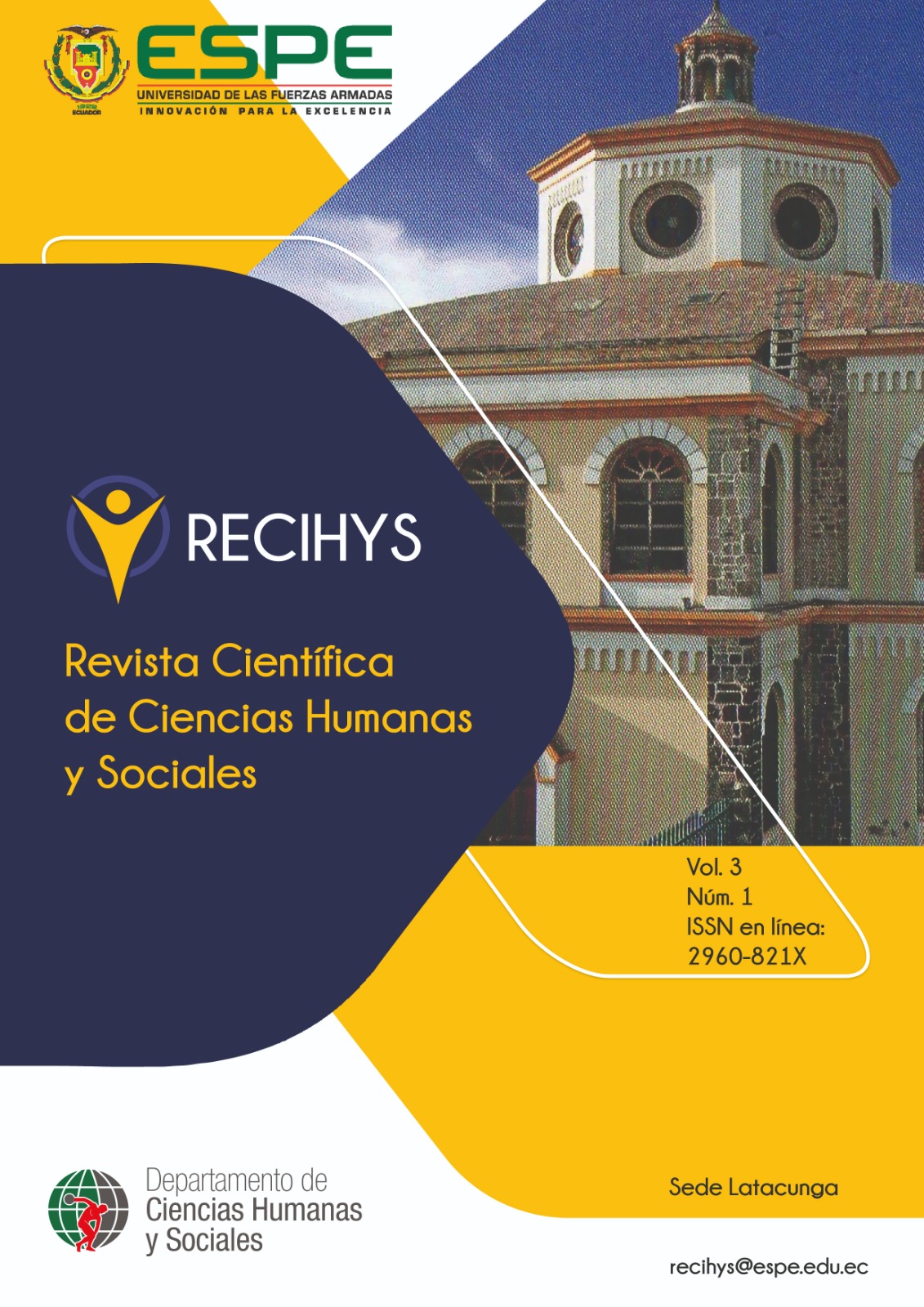Digital tangram in the identification of basic geometric figures in children aged 4 to 5 years
Main Article Content
Abstract
The research work focuses on the study of the digital tangram in the identification of basic geometric figures in children from 4 to 5 years old. The objective was based on analyzing the digital tangram in the identification of basic geometric figures at Unidad Educativa de Educación Inicial “Paraíso del Saber”, working within the framework of the information society exploring training alternatives in education that guarantee student learning, working within the framework of the Information Society, exploring training alternatives in education that guarantee student learning, the development of visual reasoning skills, logical operations and interactivity, a quantitative approach was used with a pre-experimental design of correlational scope, a population of 20 children from early education at Unidad Educativa “Paraíso del Saber” were considered; in which an observation sheet was made with an assessment scale of 3 dimensions and 8 indicators in two periods: Pretest and Posttest, the results revealed that the application of technological resources contribute to the identification of the basic geometric figures, which was determined through the Wilcoxon coefficient hypothesis test concluding that technological tools contribute to significant learning in children.
Downloads
Article Details
Authors who publish in this journal agree to the following terms: Authors retain the copyright and guarantee the journal the right to be the first publication of the work, as well as, licensed under a Creative Commons Attribution License that allows others share the work with an acknowledgment of the authorship of the work and the initial publication in this journal. Authors may separately establish additional agreements for the non-exclusive distribution of the version of the work published in the journal (for example, placing it in an institutional repository or publishing it in a book), with acknowledgment of its initial publication in this journal. Authors are allowed and encouraged to disseminate their work electronically (for example, in institutional repositories or on their own website) before and during the submission process, as it may lead to productive exchanges as well as further citation earliest and oldest of published works.
How to Cite
References
REFERENCIAS
Alulima, T. F. (2020). Universidad nacional de Loja. Obtenido de https://dspace.unl.edu.ec/jspui/bitstream/123456789/23108/1/TATIANA%20GRANDA.pdf?utm_source=chatgpt.com
Angena, M. (2019). Observación en la escuela. Cuenca: Gráo.
Betancourt, L. J. (2022). Universidad Pedagógica Enrique José Varona. Obtenido de https://www.redalyc.org/journal/3606/360673304021/html/
Brand, K. O. (2021). Repositorio de la Univerdad Minuto de Dios. Obtenido de https://repository.uniminuto.edu/server/api/core/bitstreams/2bf88289-dc73-4431-9894-a2a9a20831ae/content
Burgos Laython, D. (2022). Repositorio Unad. Obtenido de https://repository.unad.edu.co/handle/10596/49024
Caraballo. (2017). Beneficios de jugar al tangram para niños. Guía Infantil. Obtenido de https://www.guiainfantil.com/articulos/educacion/juegos/beneficios-de-jugar-al-tangram-para-ninos/
Cokitos. (2024). Cokitos. Obtenido de https://www.cokitos.com/tangram-online/
Comunicación, L. d. (2013). Obtenido de https://www.arcotel.gob.ec/wp-content/uploads/downloads/2013/07/ley_organica_comunicacion.pdf?utm_source=chatgpt.com
Cuevas, Francisco Flores. (2022). Revista Iberoamerocana para la Investigacion y Desarrollo Educativo. Obtenido de https://www.ride.org.mx/index.php/RIDE/article/view/1024/3465?utm_source=chatgpt.com
De Jesús Ulerio, L. F. (2024). Las estrategias didácticas en los procesos de enseñanza-aprendizaje. Obtenido de https://www.mlsjournals.com/pedagogy-culture-innovation/article/view/2773?utm_source=chatgpt.com
Dote, J., Nahuelhual, P., Cubillos, R., Fuentes, G., & Zuñiga, J. (2020). 3D-printed hand prostheses function in adolescents with congenital hand amputation: a case series. Rev Chil Pediatr, III(91), 410-417.
EDUCACIÓN, L. O. (2011). LEY ORGÁNICA DE EDUCACIÓN. Obtenido de https://oig.cepal.org/sites/default/files/2011_leyeducacionintercultural_ecu.pdf?utm_source=chatgpt.com
Educacion, M. d. (2014). Obtenido de https://educacion.gob.ec/wp-content/uploads/downloads/2016/03/CURRICULO-DE-EDUCACION-INICIAL.pdf
García, C. J. (13 de Abril de 2023). EFICACIA DEL USO DE HERRAMIENTAS TIC. Obtenido de https://repositorio.comillas.edu/xmlui/bitstream/handle/11531/75566/TFG-CazorlaGarciaCarlosJavier.pdf?sequence=1&isAllowed=y
Godoy, A. B. (2023). Repositorio UNAD. Obtenido de https://repository.unad.edu.co/jspui/bitstream/10596/58578/1/abarragango.pdf?utm_source=chatgpt.com
González, F. A. (2022). RIDE. Revista Iberoamericana para la Investigación y el Desarrollo Educativo. Obtenido de https://www.ride.org.mx/index.php/RIDE/article/view/1024/3465#content/contributor_reference_2
Gonzalez, R. &. (2019). La inclusión educativa y el uso de recursos digitales. Revista de Educación Inclusiva, 14(3), 45-58.
Guevaraa, L. A. (2023). Ciencia Latina Internacional . Obtenido de file:///C:/Users/VANTEC/Downloads/6179-Texto%20del%20art%C3%ADculo-24519-2-10-20230801.pdf
María, R. C. (2014). Universidad Internacional de la Rioja. Obtenido de https://reunir.unir.net/bitstream/handle/123456789/2276/Romera-Blasco.pdf?utm_source
Martin Mateos, P. P. (2021). Universidad de la Laguna. Obtenido de https://riull.ull.es/xmlui/bitstream/handle/915/25134/El%20aprendizaje%20matematico%20con%20el%20tangram%20y%20juegos%20de%20reglas.pdf?sequence=1
Mg. Carlin Ramos, J. (2021). Universidad Nacional del Santa . Obtenido de “Los Materiales Didácticos Virtuales y su influencia en el: https://repositorio.uns.edu.pe/bitstream/handle/20.500.14278/4777/Tesis%20Carlin%20Ramos.pdf?isAllowed=y&sequence=1
Moya, C. M. (2023). Obtenido de https://repositorio.uta.edu.ec/server/api/core/bitstreams/20371449-6655-493a-98af-168ef3f5a224/content
Moya, C. M. (2023). Repositorio UTA. Obtenido de https://repositorio.uta.edu.ec/server/api/core/bitstreams/20371449-6655-493a-98af-168ef3f5a224/content
Mschools. (2022). Obtenido de https://mschools.com/es/integracion-de-tecnologia-a-partir-del-tangram/
Orrego, J. d. (2017). Repositorio Universidad de Salamanca. Obtenido de https://gredos.usal.es/bitstream/handle/10366/137426/DDOMI_VenegasOrrego.pdf?sequence=1
Sampieri, H. (2019). Metodología de la investigación. Madrid: Onix.
Sanchez, M. E. (2021). Universitat Oberta de Catalunya. Obtenido de https://openaccess.uoc.edu/bitstream/10609/133487/6/msanchezsanchezTFM0721memoria.pdf
Solano, R. E. (2019). Repositorio ECCI. Obtenido de https://repositorio.ecci.edu.co/bitstream/handle/001/3172/Trabajo%20de%20grado.pdf?isAllowed=y&sequence=1
Soto, M. A. (2021). Repositorio UNAL. Obtenido de https://repositorio.unal.edu.co/bitstream/handle/unal/80471/1059784619.2021.pdf?isAllowed=y&sequence=2
Stanley, A. (2020). Experimental and Quasi-Experimental Designs for Research. Caracas: Muyit.
Tejera, M. R. (2020). Universidad de Valladolid . Obtenido de https://uvadoc.uva.es/bitstream/handle/10324/3992/TFG-G364.pdf?sequence=1&utm_source

